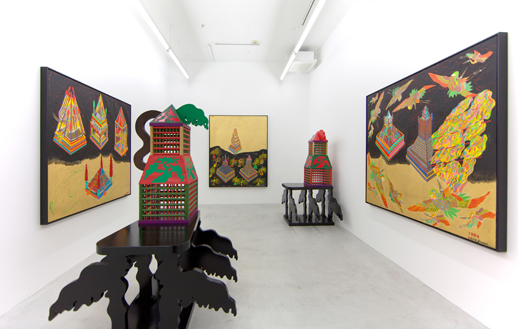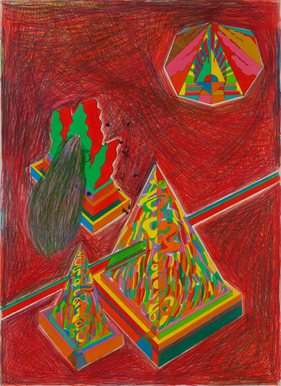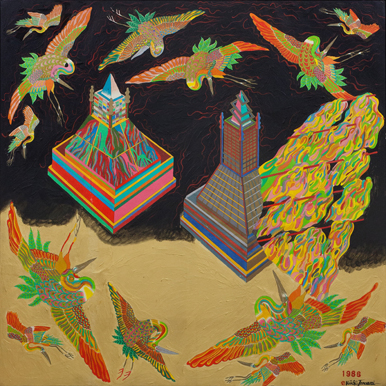Goldfish & Pyramids

A quick online image search of Keiichi Tanaami’s work could misleadingly dissuade one from any further research. But don’t be put off. As a multi-disciplinary artist born before the outbreak of WWII, Tanaami’s long career has endured many phases, most recently culminating in a brand of exaggerated pop art that unashamedly assaults the senses. Split open with sunbursts and brimming with Ben-Day dots, garish, kaleidoscopic patterns of cartoon characters have become his signature motifs. Tanaami’s work hasn’t always been this brash, however.
After the pop art and psychedelia boom of the 1960s and 70s, his work underwent a radical transformation in the 1980s, a shift prompted in part by a near-fatal struggle with pulmonary edema, a condition that severely affects breathing. At this time he began to discard the imagery of popular culture and turned to cultivating a multi-media collection of symbols that reflected a more personal mythology. Nanzuka Gallery spent this summer chronicling this period of activity with two exhibitions, or “chapters,” titled “Passage in the Air (1975-1993)”.
In the final installment of the exhibition, Tanaami’s works are firmly tethered to the decade of their production. If only on the surface, they speak incredibly of the eighties. Sharp and zingy, they’re full of fast colors and easy lines. While primary pigments and high contrasts make demands upon the eye, generous golden expanses push up against black borders. These works amount to much more than exercises in style, yet there is something about combining red with jade green that feels as though it could only really have been made during one era.

The dynamism of the artist is communicated through the composition of the gallery space, with videos playing on a small screen, sculptures rising from the ground, and walls filled with two-dimensional works on paper and canvas, employing various combinations of ink, paint and pencil to describe fantastical structures in vibrant hues. Resembling pyramids with vaguely phallic fence posts, Tanaami situates these structures alongside cranes, turtles and elephants. Precisely what kinds of rituals are enacted in these uninhabited sites remains unclear. Amongst this array of objects and characters, certain backgrounds are formed from scribbled textures that seem to buzz with electricity. Fizzing mystically, something cultish seems astir.
Tanaami’s work from this period shares select qualities with his wider oeuvre. Visually, the most striking similarity is the artists’ attraction to pattern. Whether it’s found among fish scales, bird feathers or turtle shells, pattern is a subject that recurs time and again. It’s even visible in his most mysterious of inventions: multicolored strands that weave their way through otherworldly scenes. Sometimes these strands appear like prayer flags, others in liquid forms resembling streams of rainbows. No matter what shape they take, they rarely fail to teem with supernatural associations. In this way, perhaps they connote the very airborne passages to which the title refers, or perhaps they themselves visualize breath?

Tanaami’s art is filled with symbols waiting to be read, some of which may be understood through his biography. Born in 1936 in Tokyo, his childhood was marred by the constant bombing of the city from 1941 onwards, culminating in the Great Tokyo Air Raid in 1945. Subsequently, searchlights, fighter planes and firebombs became recurring motifs in his work. As did goldfish. This seemingly unrelated image was imprinted upon his mind, as he witnessed the horrifying events of his place and time from a room shared with his grandfather’s deformed goldfish, flares of blinding light reflected in the water of its tank. Unsurprisingly, these events had a profound and lasting impact on his work and perspective.
Of course, pinpointing meaning is easier with direct references to biographical episodes. For much of the eighties and in the case of the majority of the work on show here, Tanaami makes only oblique allusions with symbols striking internal chords Utilizing abstraction to explore the subconscious, or more specifically, the artist’s own subconscious, the works do not lend themselves to easy analysis, and any attempt to discern particular meanings presents the danger of muddling empathy with guesswork. That said, in this world of symbolism, we as viewers are primed to look for meaning as soon as we enter the gallery.
Overall, these works are the fruits of a kind of quest undertaken by an artist who has come back from the brink. They show Tanaami’s bonds with the world, his personal experiences, while also reflecting the hallucinations he encountered during a life-threatening illness. As crucial as this backdrop of tragedy and trauma is, there is a positive message to be gleaned from the pyramids. “Passage in the Air (1975-1993)” is a highly stylized, esoteric meditation on mortality, but the pyramids aren’t just pyramids. Nor are they prisms or mountains; they’re places of refuge, tombs in which to survive death.

Nick West
Nick West



